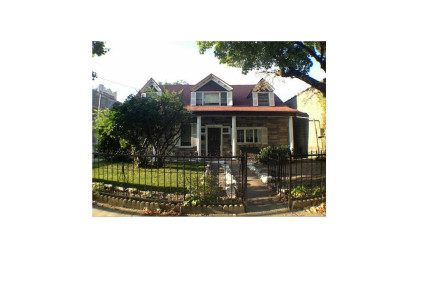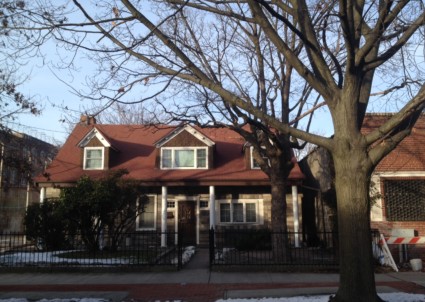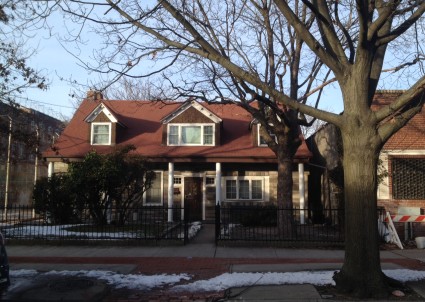Lady Moody-Van Sicklen House, Brooklyn
Address: 27 Gravesend Neck Road, Brooklyn, NY 11223
Built: c.1760-1810
LPC Action: LPC held hearings for the in Lady Moody-Van Sicklen House 1970 and 2004
LPC Backlog Hearing: Prioritized for designation
Designated on April 12, 2016
The Lady Moody-Van Sicklen House is a rare surviving example of an 18th century Dutch-American farmhouse and a reminder of Brooklyn’s agricultural past. In addition to being one of the oldest houses in Brooklyn, it is also the borough’s only extant house of its age and type to be built of stone. While it is unlikely that any part of the house dates to her ownership of the property, the house sits on a lot once owned by Lady Deborah Moody, an English settler who founded Gravesend and one of the first women to be granted land in the New World. The house features a gable roof with overhanging eaves and an end chimney, typical features of 18th century Dutch-American farmhouses. It is one of only two extant houses that adhere to the original four-square plan laid out for the colonial town of Gravesend. This plan is unique in New York City, consisting of 16 acres per square, and is still visible in the modern street grid. The house is, therefore, integral to Gravesend’s history and identity. Subsequent owners included the prominent Van Sicklen family and William E. and Isabella Platt, who renovated the house in the Arts and Crafts style in the early 20th century, and advertised its association with Lady Moody.
LPC Statement of Significance:
Located in Gravesend, Brooklyn, the Lady Moody-Van Sicklen House is a rare surviving example of an eighteenth-century Dutch-American farmhouse, and the only known extant 18th century farmhouse of stone construction in Brooklyn. In addition to the stone walls, the house features a gable roof with wide, overhanging eaves and an end chimney that are typical of 18th century construction.
The house was built on a portion of the original house lot of Lady Deborah Moody, who founded Gravesend in the 1640s. An Anabaptist (forerunners of Quakers), Lady Moody first left England and then was forced out of Massachusetts because of her religious beliefs. Lady Moody planned the distinctive layout of Gravesend, the first English settlement in the New Netherlands, and is credited as being the first woman to establish a European colony in the United States. The current house may incorporate features of Lady Moody's 1640s-50s house.
Farmer and property owner Ferdinandus Van Sicklen acquired this land in 1702. The Van Sicklen family most likely built the present house. In the 1840s-50s the house and land were acquired by Cornelia Van Siclen Hicks and her husband Thomas Hicks, a fisherman. The Hicks family occupied the house until 1903/06 when it was sold to realtor William E. Platt, who with his wife Isabella, made extensive alterations to the house in keeping with the prevalent Arts and Crafts aesthetic including the addition of dormer windows and stuccoing the exterior.
Most Brooklyn Dutch-American farmhouses are of wood. Bailey documented four Dutch-American stone farmhouses in Brooklyn, including this house. Two have subsequently been demolished and due to a boundary change the Onderdonk House, a designated New York City Landmark, is now in Queens, making the Lady Moody-Van Sicklen house the only extant 18th century stone farmhouse in Brooklyn. Most stone houses were built in areas adjacent to ridges where stone was available, the use of stone for the Lady Moody-Van Sicklen house in flat, coastal Gravesend is highly unusual. Several scholars of eighteenth century Dutch-American houses have made a correlation between the use of stone and the presence of slave labor. Late 18th century Kings County had the largest percentage of slaves outside the south, and the Dutch farmers of Kings County were the main slave owners, reinforcing the likelihood that the Van Sicklens, farmers of Dutch descent, had the house built.
Many Dutch-American farmhouses have been moved from or reoriented on their original sites. The Lady Moody-Van Sicklen house remains on its original site in its historic location making it one of the few Dutch-American farmhouses on its original site, which additionally is a prominent and central location within the colonial plan of Gravesend. The Lady Moody-Van Sicklen house is one of the few remaining built forms that represents the early history of Gravesend, a significant New York colonial community.




